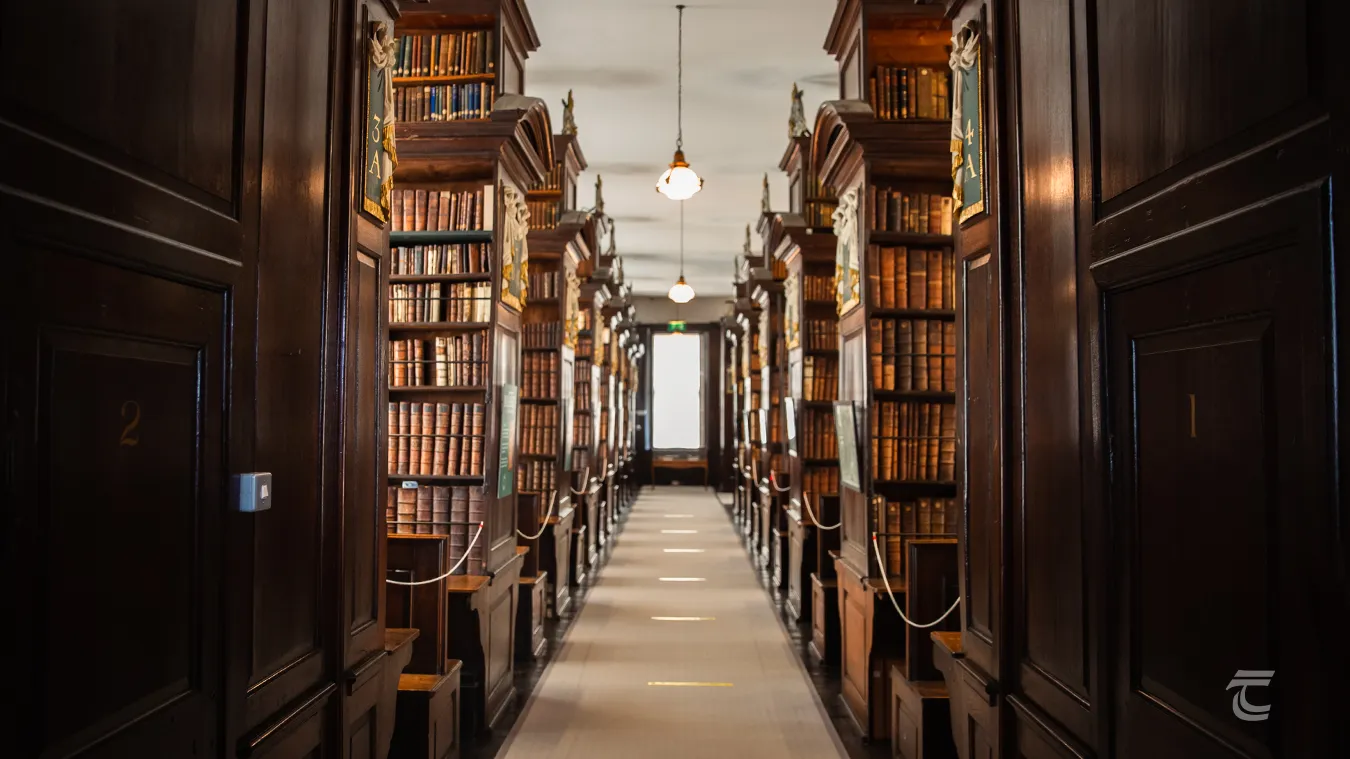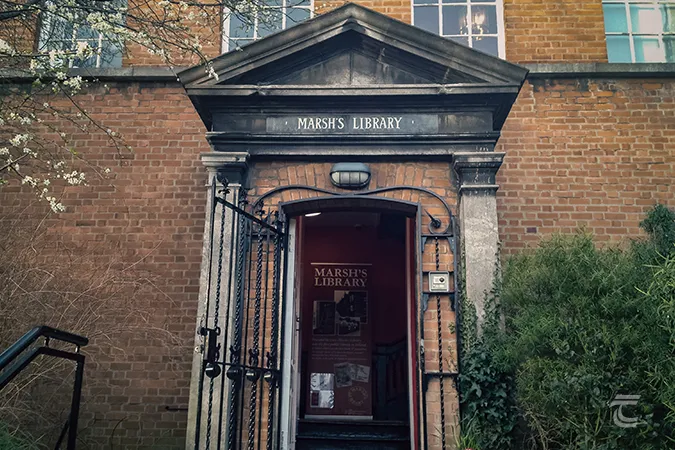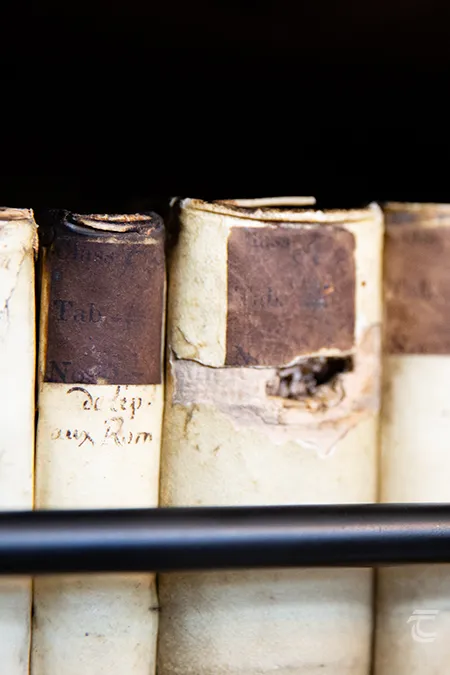Marsh’s Library
Located in St Patrick’s Close near to the cathedral, Marsh’s Library is Ireland’s oldest public library, and is a must see for all book-lovers visiting Dublin. The interior of this beautiful building has remained largely unchanged over the past three hundred years, since it was opened as Ireland’s first public library in 1707. The majority of its approximately 25,000 volumes date to the 16th–18th centuries, but it also holds nearly 100 pre-15th century works, and 300 manuscripts. The books are on display in two galleries, connected by a handsome reading room.
The grandiose first gallery houses books covering subjects like law, history, classics, politics and science. The volumes still maintain their original positions from when the library was first installed – a stark difference to my own more modest collection which gets jumbled up every time I go rummaging for a particular book! The second gallery has a more mixed collection of scientific and linguistic texts, along with plays and poems. The atmosphere of generations of scholars hangs heavy in the air in the library. Some of Ireland’s literary greats like Bram Stoker and James Joyce perused these very volumes, seeking their own inspiration.
Archbishop Narcissus Marsh is the man who is credited with the construction of the library. He was born in 1638 in North Wiltshire in England. His biography paints a picture of a man who was moved by a love of learning, curiosity and science. A true polymath, his interests were very eclectic. He had works of note in insect classification, acoustics, comets, and the improvement of scientific instruments. He fled Ireland in 1689 like many protestants, only to return following the victory of King William. He was a key figure in the passing of many of the Penal Laws that so repressed Irish Catholics. His love of learning had long fostered a desire to build a public library. But it was not until he was appointed as Archbishop of Dublin that he had the money and power to do so. Using his own funds, he had his library constructed next to his home in the Bishop’s Palace of St Sepulchre. His home may be lost, and now under Kevin Street Garda Station, but Marsh’s marvellous library lives on, as a testament to its founders love of learning.
For practical information about visiting this site Click Here
Located in St Patrick’s Close near to the cathedral, Marsh’s Library is Ireland’s oldest public library, and is a must see for all book-lovers visiting Dublin. The interior of this beautiful building has remained largely unchanged over the past three hundred years, since it was opened as Ireland’s first public library in 1707. The majority of its approximately 25,000 volumes date to the 16th–18th centuries, but it also holds nearly 100 pre-15th century works, and 300 manuscripts. The books are on display in two galleries, connected by a handsome reading room.
The grandiose first gallery houses books covering subjects like law, history, classics, politics and science. The volumes still maintain their original positions from when the library was first installed – a stark difference to my own more modest collection which gets jumbled up every time I go rummaging for a particular book! The second gallery has a more mixed collection of scientific and linguistic texts, along with plays and poems. The atmosphere of generations of scholars hangs heavy in the air in the library. Some of Ireland’s literary greats like Bram Stoker and James Joyce perused these very volumes, seeking their own inspiration.
Archbishop Narcissus Marsh is the man who is credited with the construction of the library. He was born in 1638 in North Wiltshire in England. His biography paints a picture of a man who was moved by a love of learning, curiosity and science. A true polymath, his interests were very eclectic. He had works of note in insect classification, acoustics, comets, and the improvement of scientific instruments. He fled Ireland in 1689 like many protestants, only to return following the victory of King William. He was a key figure in the passing of many of the Penal Laws that so repressed Irish Catholics. His love of learning had long fostered a desire to build a public library. But it was not until he was appointed as Archbishop of Dublin that he had the money and power to do so. Using his own funds, he had his library constructed next to his home in the Bishop’s Palace of St Sepulchre. His home may be lost, and now under Kevin Street Garda Station, but Marsh’s marvellous library lives on, as a testament to its founders love of learning.
For practical information about visiting this site Click Here

The elegant interior of Marsh’s Library • Dublin
The Huguenots and Marsh’s Library

Centuries old volumes still in their original positions • Marsh’s Library
The collection of Marsh’s Library was greatly enhanced by the first librarian – Élie Bouhéreau. He was a Huguenot who fled France with his family to escape persecution in the late-17th century. The Huguenot community found sanctuary in Ireland, and were given the use of the Lady Chapel of St Patrick’s Cathedral as a place of worship. Élie was appointed by Archbishop Narcissus Marsh as the first librarian of his new library. This was a great coup for Archbishop Marsh, not only was Éile a highly intelligent person who was ideal for the job, but he had also managed to smuggle out his vast and important collection of books and manuscripts, which he agreed to bequeath to the library upon his death.
His books remain there now for all to see in the Reading Room that connects the two galleries. They are still shelved together in their original bindings. However these volumes also tell another story than that of their contents and Élie Bouhérau – if you look closely at some of the volumes you can still see bullet holes. A legacy of stray fire during the tumultuous 1916 Easter Rising in Dublin.
One of the most remarkable features of the library are the lockable cages at the end of the second gallery. They served as small reading areas, scholars wishing to peruse any of the valuable books would find themselves locked in to prevent them stealing any copies. Perhaps a more effective security system than a library fine! Outside the library you can find the elegant gardens, once the private demesne of the library keeper now it serves as a bright burst of greenery after being in the elegant book-filled gloom of the interior.
Today Marsh’s Library is a rewarding visit, with an ever-changing exhibition that highlights different aspects of the collection throughout the year. If you can, please consider leaving a donation in the collection boxes in the library – the funds go towards the conservation and upkeep of the precious books.

Centuries old volumes still in their original positions • Marsh’s Library
Upper left: the entrance to Marsh’s Library • Lower left: the lockable cages • Right: bullet holes from the 1916 Rising
Top: the entrance to Marsh’s Library • Middle: bullet holes from the 1916 Rising • Bottom: the lockable cages
Explore more sites around Dublin




